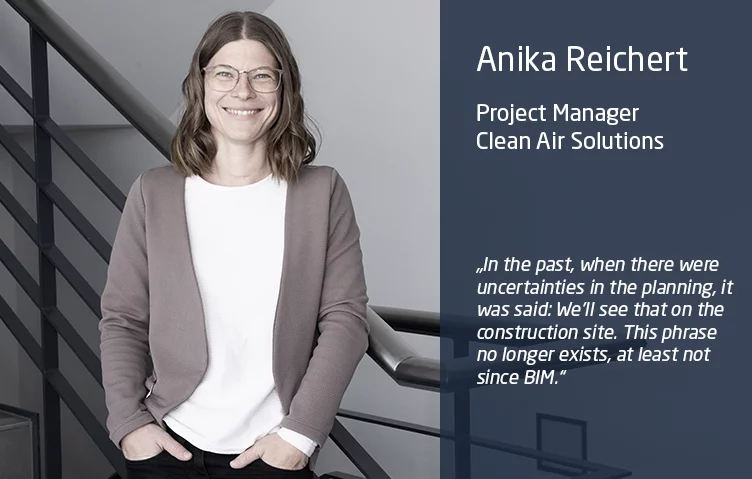“In the past, when there were uncertainties in planning, people used to say: 'We’ll figure it out on site.' That sentence has become obsolete since BIM was introduced.”
Dressed smart casual and with a smartphone in hand, Anika Reichert arrives at the tech lunch. She chooses pasta with salmon sauce and a sparkling apple juice. During the conversation, she talks about her work and the challenges of managing large dry room projects. The meal ends with an espresso.
Ms. Reichert, what does a project manager in dry room construction need?
First, you need a good overview and strong nerves. There’s a lot to keep in mind. This is especially true when you're executing a project as a general contractor. As well as coordinating internal colleagues, you also have to manage external partners.
What are the advantages of hiring a general contractor?
For our clients, it’s ideal because they hand everything over to a single source. From planning to maintenance, they have one central point of contact. This streamlines processes, especially given the number of interfaces involved in dry room construction, and it’s always the fastest way to resolve issues.
What does that mean for financial security in large-scale projects?
That’s an important topic. With us, clients have the backing of the Schunk Group, which provides a level of security that competitors usually can't offer. Anyone who commissions us knows the project will be completed—no matter what. That’s especially crucial for large-scale projects that run over several years.
What are the biggest challenges associated with dry rooms?
We work on many dry room projects for the production of battery cells for electric vehicles and for chip manufacturing. These applications come with extremely strict requirements and very tight tolerances. On top of that, there are extremely low dew points—as low as minus 60 degrees. However, the greatest challenge is always executing the planning in such a way that the dry room functions perfectly in the end.
Where do problems typically arise?
As with most projects, problems tend to occur when there's a deviation from a solid plan. This can occur when framework conditions change, the client introduces new requirements or the supplier delivers something different to what was agreed. In the worst case, the entire plan then has to be revised and rechecked.
Is there a typical example of this in dry room projects?
Yes, a classic example is changes to the process technology. These are often very complex, since the control systems and supply lines for the production machines are usually located one floor above the dry room. In addition to cables, you sometimes have to route pipes carrying liquids heated to up to 300 degrees through the ceiling. The thermal effects alone present a significant challenge in maintaining airtightness. However, if the dimensions of a penetration need to change at short notice because something on the machine side has been modified, that can have serious consequences.
Are there any other challenges?
In general, people are the biggest sources of disruption in dry rooms, simply because they bring a lot of moisture into the space. But that’s something we account for right from the planning stage. All wall and ceiling penetrations are also critical points. As well as supply lines for machines, this includes airlocks and emergency exit doors leading outside. These areas require extremely careful execution using the correct materials. Depending on the project, even the floor coating or wind load on the roof may need to be considered during planning.
What is your main task in all of this?
I have to maintain an overview. I also have to manage the 'magic triangle' of project management — cost, quality and timing — in a way that ensures a positive outcome for everyone. To do that, I need to know at all times what was originally offered, what changes have occurred and what impact those changes have had. Ultimately, it is my responsibility to ensure that the various technical solutions on site integrate seamlessly and that the finished system operates reliably as a whole.
So does that mean a lot of communication is required?
Definitely. In a large-scale project, that can mean 100 or more messages a day that I need to read, prioritize, organize and direct. On top of that, there are face-to-face conversations, phone calls, online meetings and steering groups. It all adds up. My aim is always to be one step ahead of the customer and the construction site. That's not always easy, especially when things are changing rapidly on the ground. But I can always rely on my colleagues for support.
Speaking of colleagues—are there many women on your team?
Let’s put it this way: there could definitely be more, especially since I believe mixed teams work better. But what matters most to me is that all colleagues—regardless of gender—work reliably, responsibly, and on time. That’s absolutely essential, especially in fast-moving large-scale projects.
Which large-scale project are you currently working on?
Currently, I am working on the FFB battery research project at the Fraunhofer Institute in Münster. I managed the project during the first construction phase. The second phase involves 10,500 m² of cleanroom and dry room space, making it the largest contract in the company’s history. It is a great honor for me to manage this project.
What aspects of this project require special attention?
As with all large projects, there are many stakeholders with various requirements and potential changes. My internal team alone consists of 30 people, plus external partners. Also, the entire project is planned and executed using BIM. This means that the entire plan must be detailed and precise from the beginning. The phrase "We'll figure it out on site" no longer applies. By then, it’s too late. For me, this means I have to pay closer attention to every detail during the planning phase.
What do you like about your job?
I enjoy working with different people every day, and I like that no two days are the same. There’s always something new, so it never gets boring, which is great.
Quick Facts: Anika Reichert
Anika Reichert holds a degree in Mechanical Engineering and Process Engineering. After studying in Bayreuth with a focus on design and production technology, she gained experience in project management at various positions before joining Weiss Klimatechnik at the end of 2022. In her personal life, she prefers structure and planning as well. This is important because with two children, there’s little time for hobbies like occasionally playing the piano.

